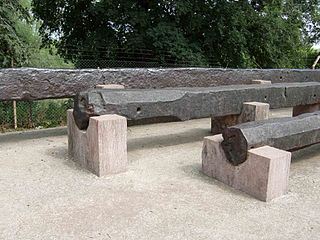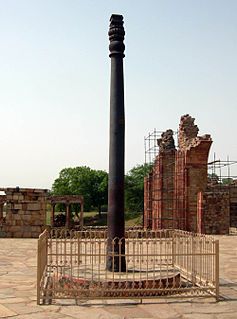 W
WThe Allahabad pillar is a Stambha, containing one of the Pillars edicts of Ashoka, possibly erected by Ashoka, Emperor of the Maurya dynasty, who reigned in the 3rd century BCE or it may have prior origins. While it is one of the few extant pillars that carry Ashokan edicts, it is particularly notable for containing later inscriptions attributed to the Gupta emperor Samudragupta. Also engraved on the stone are inscriptions by the Mughal emperor Jahangir, from the 17th century.
 W
WThe Dhar iron pillar is a now-fragmented iron column located in the Dhar town of Madhya Pradesh, India. The exact origins of the pillar are unknown, but according to the local tradition, it was a victory column erected by the 11th century Paramara king Bhoja.
 W
WThe following is an overview of Edicts of Ashoka, and where they are located.
 W
WThe Heliodorus pillar is a stone column that was erected around 113 BCE in central India in Besnagar. The pillar was called the Garuda-standard by Heliodorus, referring to the deity Garuda. The pillar is commonly named after Heliodorus, who was an ambassador of the Indo-Greek king Antialcidas from Taxila, and was sent to the Indian ruler Bhagabhadra. A dedication written in Brahmi script was inscribed on the pillar, venerating Vāsudeva, the Deva deva the "God of Gods" and the Supreme Deity. The pillar also glorifies the Indian ruler as "Bhagabhadra the savior". The pillar is a stambha which symbolizes joining earth, space and heaven, and is thought to connote the "cosmic axis" and express the cosmic totality of the Deity.
 W
WThe iron pillar of Delhi is a structure 23 feet and 8 inches high with 16 inches diameter that was constructed by Chandragupta II, and now stands in the Qutb complex at Mehrauli in Delhi, India. It is famous for the rust-resistant composition of the metals used in its construction. The pillar weighs over three tonnes and is thought to have been erected elsewhere, perhaps outside the Udayagiri Caves, and moved to its present location by Anangpal Tomar in 11th century.
 W
WThe Jaipur Column is a monumental column in the middle of the courtyard in front of Rashtrapati Bhavan, the presidential residence in New Delhi, Delhi, India. In 1912 Madho Singh II, the Maharaja of Jaipur, offered to sponsor its construction to commemorate the 1911 Delhi Durbar and the transfer of the capital of India from Kolkata to New Delhi.
 W
WThe Lascar War Memorial, located on Napier Road in the Hastings area of Kolkata, is a memorial dedicated to the memory of the 896 lascars who died serving on ships of the Royal Navy and British Merchant Service during World War I.
 W
WLauriya Araraj, also Lauriya Areraj, is a location name in the East Champaran District of the State of Bihar in India.
 W
WMahakuta Pillar, also known as Makuta pillar, Magada stambha or Mangalesa Dharma Jayastambha, is a deep red sandstone pillar with an early 7th-century inscription of Early Western Chalukya era. It was found near Mahakuta group of Hindu temples near Badami, Karnataka, India. Inscribed with 16 lines of Sanskrit in Old Kannada script by king Mangalesha, it is an important and partly disputed source of historic information about the times of Badami Chalukya, the dynasty, and his influential father Pulakeshin I.
 W
WThe Manhai pillar capital is the portion of an ancient capital found in the city of Manhai, one and half miles to the east of the eastern gateway of Kausambi, Uttar Pradesh in India, and published in 1980 in "Reh Inscription of Menander And The Indo-greek Invasion Of The Ganga Valley" by G. R. Sharma. The fragmentary stone-slab is displayed in the Museum of the Centre of Advanced Study, Department of Ancient History, Culture and Archaeology, University of Allahabad.
 W
WThe Pataliputra capital is a monumental rectangular capital with volutes and Classical Greek designs, that was discovered in the palace ruins of the ancient Mauryan Empire capital city of Pataliputra. It is dated to the 3rd century BCE.
 W
WThe pillars of Ashoka are a series of monolithic columns dispersed throughout the Indian subcontinent, erected or at least inscribed with edicts by the Mauryan Emperor Ashoka during his reign from c. 268 to 232 BCE. Ashoka used the expression Dhaṃma thaṃbhā, i.e. "pillars of the Dharma" to describe his own pillars. These pillars constitute important monuments of the architecture of India, most of them exhibiting the characteristic Mauryan polish. Of the pillars erected by Ashoka, twenty still survive including those with inscriptions of his edicts. Only a few with animal capitals survive of which seven complete specimens are known. Two pillars were relocated by Firuz Shah Tughlaq to Delhi. Several pillars were relocated later by Mughal Empire rulers, the animal capitals being removed. Averaging between 12 and 15 m in height, and weighing up to 50 tons each, the pillars were dragged, sometimes hundreds of miles, to where they were erected.
 W
WThe Rampurva capitals are the capitals of a pair of Ashoka Pillars discovered in c. 1876 by A. C. L. Carlleyle. The archaeological site is called Rampurva, and is located in the West Champaran district of the Indian state of Bihar, situated very close to the border with Nepal. The lion capital is now in the Indian Museum in Kolkota, while the bull capital is located at the center of the porch of the Rashtrapati Bhavan, the Indian Presidential Palace.
 W
WSanjan Stambh is a memorial column at Sanjan in Gujarat. It commemorates the arrival of Zoroastrians there eleven centuries ago—a group of shipwrecked migrants who had fled Muslim persecution after the downfall of the Persian Empire and were welcomed to India by Hindu king Jadi Rana.
 W
WThe Tyagada Brahmadeva Pillar is a decorated free standing pillar, 2.3 m tall, commissioned by Chamundaraya, an important minister and commander in the Western Ganga kingdom, during the rule of King Marasimha II (963–975), Rachamalla IV (975–986) and Rachamalla V. The pillar dates to around 983 C.E. and exists on the Vindyagiri hill in the important Jain heritage town Shravanabelagola, in the Karnataka state, India. On the base of the pillar, on the north side, is an inscription in old Kannada language of the same period, which according to epigraphist and historian B.L. Rice confirms Chamundaraya's involvement in the erection of the pillar. Free standing pillars are a characteristic feature of the Western Ganga art and are broadly classified as "Mahastambha" and "Brahmastambha".